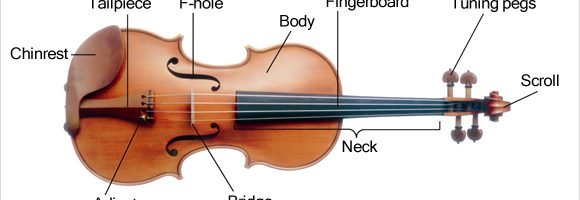About the author: Mallika is a biology student and an artist. She loves painting, dancing, and playing the violin. She enjoys volunteering with Art Sphere and helping students learn more about all forms of art!
Music is a form of expression that teaches kids the importance of commitment. It’s a way for them to express themselves creatively while also learning about other cultures and time periods. Music is also beneficial in that it teaches teamwork when in an ensemble, and it helps students practice their math skills with counting, division, and addition. Teaching kids about musical instruments can help them learn about new hobbies or passions they would like to pursue.
Grade level: Preschool – 1st Grade
What is the violin?
The violin is the highest-pitched instrument in the string family. You may have also heard it called the fiddle! The violin is hollow and made out of wood. It has four strings, and usually a bow is used to produce sound. You can also strum or pluck the strings.
Musical terms to know:
- Pitch: This is how high or low something sounds. For example, whales make low, deep sounds, so they would have a low pitch. Whistles have high sounds, and we would say they have high pitch. Violins have a high pitch.
Parts of the violin:
- Strings: The violin has four strings– E, A, D, and G. The violin can make high pitch sounds because of the E string!
- Fingerboard: This is the part under the strings. You press each string down onto the fingerboard with the fingers of your left hand, and this creates different pitches.
- Tuning pegs: You turn the pegs to either tighten or loosen the strings, and this changes the pitch. Be careful turning the pegs– if you tighten the string too much, it will break! Turn the pegs slowly and pluck the string gently to test the pitch.
- Fine tuners: These are at the bottom of the violin. They are also used to help with tuning the violin. You turn these left and right like you would with screws, and this changes the pitch of the string. The fine tuners help you make really small changes that the tuning pegs can’t do!
- Bridge: This piece supports the strings. It is also made out of wood.
- Chin rest: This is where you rest your chin!
- Shoulder rest: This is a separate piece you attach onto the back of the instrument. It makes holding the violin between your chin and shoulder much more comfortable.
What is a bow?
The bow is an important tool you need to play the violin. You move it across the strings between the bridge and fingerboard to make a smooth sound.
Parts of the bow:
- Tip: This is the pointy end of the bow.
- Frog: This is the square end at the bottom of the bow.
- Grip: This is near the frog, on the wooden part of the bow. You place your right hand here.
- Bow hair: These are the white strands on the bow. This is the part that touches the string. The bow hair is very delicate, so be careful not to touch it with your fingers.
How to Play the Violin:
Grip the violin between your left shoulder and left chin. Hold the bow in your right hand. Use your elbow to move the bow across the strings on the part between the fingerboard and the bridge.
You’re a violinist now!

